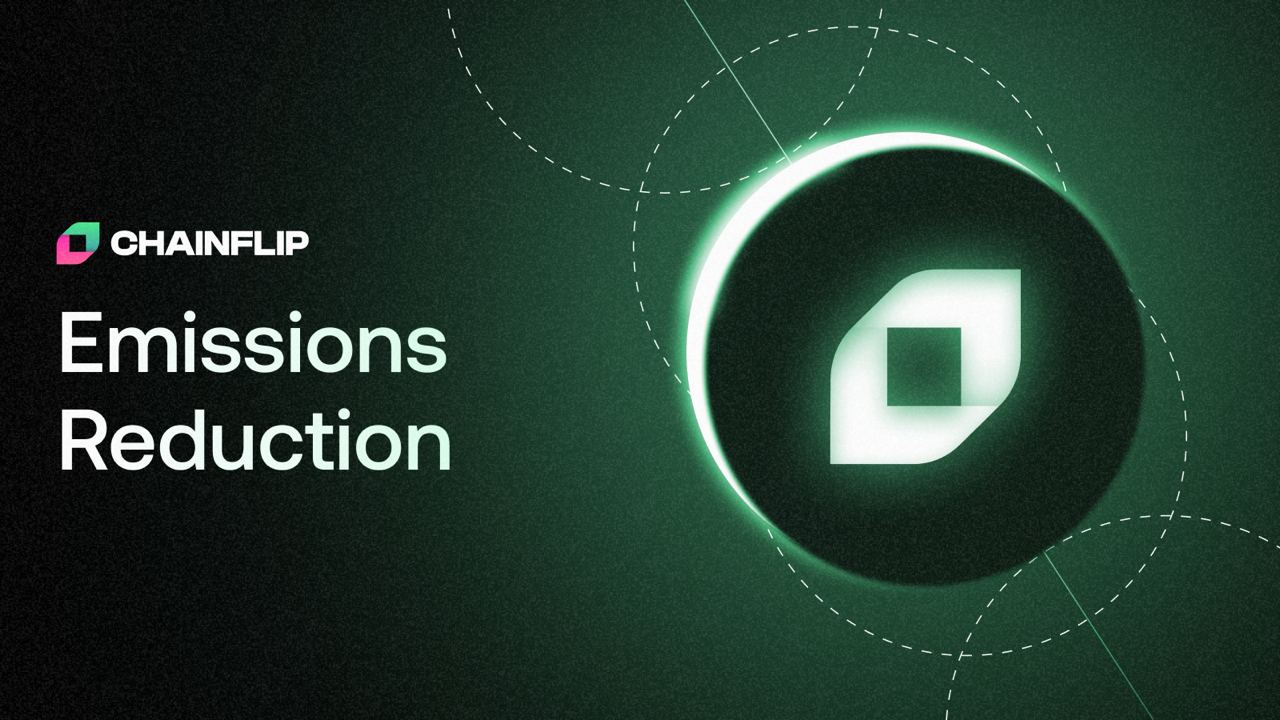Enacting an Emissions Cut for FLIP

In this post we announce a change to the FLIP emissions budget to account for months of real data on the economics of the system in the wild. I have spoken with a range of Stakeholders and believe this is the correct decision under the optimistic governance framework of Chainflip.
The Authority Rewards will be reduced from a 7% annual budget to a 4% annual budget whilst Backup Validators will have the maximum reward budget reduced to 0.5% from 1%.
Sometimes these emissions changes can be somewhat controversial in other projects, but I want to lay out the case for this change in budget, provide revised models that account for the change, and explore the potential risks and downsides - but firstly I’ll point out that changes like this were always conceivable.
FLIP Economics were never supposed to be fixed.
In my first post on the subject of emissions, the clue is in the title: “The Decentral Bank of FLIP” - implying that “interest rates” as a control mechanism, like a central bank, were at the forefront of the design considerations.
In that post I also proposed changing the emission budgets as we moved through different phases of the launch. We didn’t end up doing that but if you read those posts you’ll see that the key consideration when setting an emission budget is to work out how much economic security is worth paying for.
Even in the current version of the docs, the sentence “In the future, additional budgets may be altered or granted through governance” clearly identifies emission changes as a variable mechanism that should be continuously assessed.
With several months of real data to work with, we can take an informed look at the current state of the system and come up with new budgets to reflect that information.
The Case for Reducing Emission Budgets
All protocols should aim to have the lowest possible emission without introducing undue risks or underfunding necessary behaviours. In the case of Chainflip, Validators are currently the only permanent budget considered for the emissions system, and thus this discussion will centre on them. Considering that presupposition, the main arguments supporting a reduction can be split into three main categories.
- Expectations for staking rewards for Validators are lower than they used to be.
In the emissions documents, the concept of the Staking Equilibrium describes a reward rate that market participants globally consider to be sufficient in order to support the activities being undertaken, but not sufficient to warrant an increase in collateral commitment. No one can ever really know when an equilibrium has been reached, but there are plenty of real world examples that we can look to in order to understand where most market participants in the industry consider a ‘sufficient’ rate of return to justify running and managing a Validator.
When the system was designed, we estimated that the typical range of RoRs of mature staking protocols was between 6% and 22%. Now, looking at newer data, it seems mature protocols have dramatically reduced that offering, see: https://www.stakingrewards.com/assets/proof-of-stake
These days, those rates are more in the region of 3 - 10%, meaning the roughly 19% rate offered in the protocol at the moment is well above the standard.
As the MAB continues to grow beyond the 200k FLIP benchmark predicted when the system was devised, we can say that the current rate is more than enough to drive up the equilibrium, as the rate is much greater than what is needed to sustain this level of staking.
- We have plenty of economic security already in place.
Driving up the level of collateral committed to validators is never a bad thing, but there comes a point at which a sufficient level of economic security has been reached, and more spending on rewards achieves no material positive impact.
With nearly 34m FLIP bonded to validators (and actually more staked, that only counts the MAB * authority count), and the accompanying $100m in economic security, we are practically 10x overcollateralised in terms of the assets currently held in the liquidity accounts.
Even if the FLIP price were to halve, the level of economic security is still likely to be sufficient to protect the protocol. As you’ll see later in the analysis, it’s very unlikely the FLIP price will drop below $1.5 for any meaningful length of time given the current performance of the protocol and the reflexive nature of the buy-and-burn mechanism, where a halved price also doubles the number of tokens burned through fees.
Given these facts, it seems unlikely that achieving higher levels of staking (which, by the way, will still probably continue to rise after a cut) is necessary to protect against undue risks.
- Lower emissions cut down the bar to achieving a deflationary total supply
Perhaps the best reason of all to consider a cut in emissions is the shape of the overall token model.
FLIP’s value is predicated on limiting the supply through a direct buy-and-burn built into the protocol. The less tokens emitted, the less tokens have to be bought and burned to keep the supply capped or deflationary.
By reducing the emissions budgets, Chainflip needs less volume and less fees to achieve this negative issuance rate, and can support a higher base price.
Exploring the downsides
1. Stakers may unstake
A common concern raised when regarding reducing emissions is that it may cause stakers to withdraw their capital. I would argue that the value of the collateral is much more important to all stakers than the APY generated through staking. 18% is nice, but an emissions cut serves the interests of all stakers by improving the underlying economics of the collateral and reducing future negative pressures on its value.
Stakers in Chainflip appear to not really sell their rewards, but at some stage this must change. By ensuring everyone knows the model is more sustainable, these pressures aren't as likely to impact the decisions of long term holders.
2. Providers may be economically dissuaded from participation
A legitimate concern regarding the emissions cut is the change to the economics that may cause some staking providers to have a reduced margin to operate validators or services like stFLIP.
I have spoken to some of these stakeholders, and all agree that ultimately, yes, in the short term, this will directly impact the amount of income generated to cover costs and turn a profit as a Validator participant (particularly those with no collateral of their own). However, the long term sustainability of the token model is the only guarantee that the investment into supporting Chainflip from an infrastructure perspective pays off, and so it’s worth it in the long run.
3. We may have to change it again
As I detailed at the start of this post, it is entirely conceivable that we may have to make further changes for a number of reasons. It may also include creating smaller budgets for things like liquidity. However I think I have made the point in this article that we should always be wary of the realities around the protocol, and respond accordingly with adjustments to the token model if it requires it.
The protocol is still very young, and there is a massive amount of potential, particularly if we start hitting $100m daily volumes by the end of the year, as is our goal. If we are successful in achieving that, then we should be very enthusiastic about making further changes to capitalise on the success as well.
Thus, the possibility of further changes is a benefit, not a downside, of making changes early on.
Rollout Plan
This change is very simple to make.
The governance council will be processing governance transactions to make Direct changes to the emissions rate on Wednesday the 22nd of May. This is in order to give enough time for anyone who may be producing dashboards or doing calculations surrounding the emissions to make necessary changes to account for an altered emission rate.
As these emission parameters are standard chain parameters, a runtime upgrade or binary change will not be necessary in order to process this alteration.

